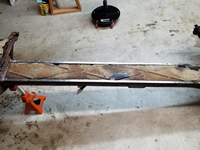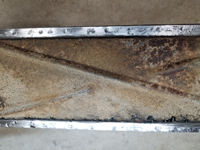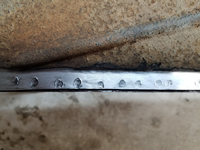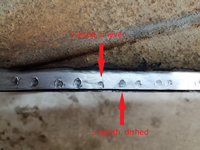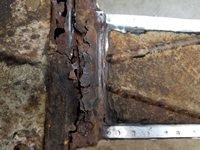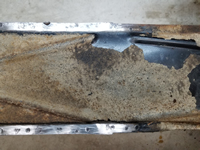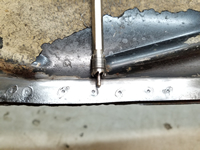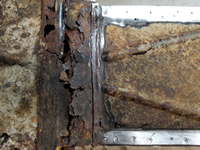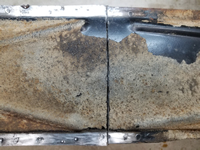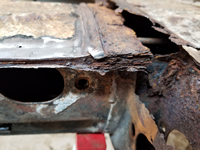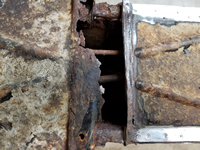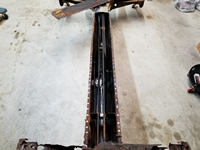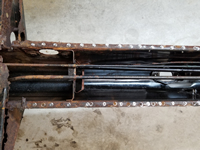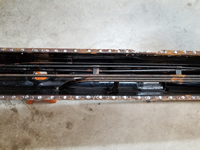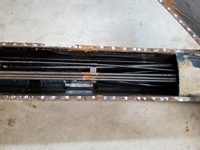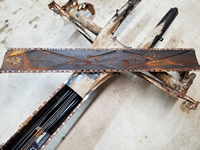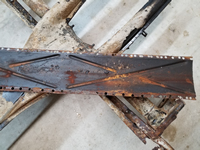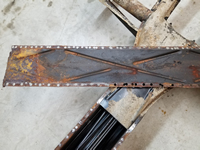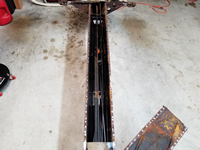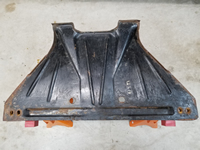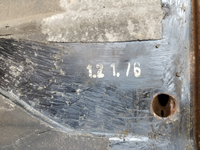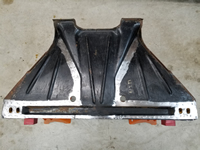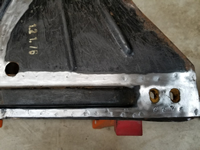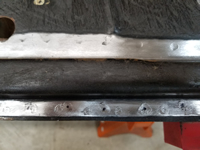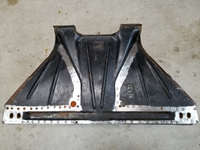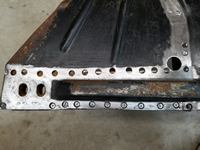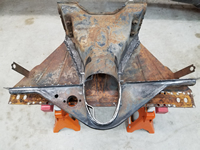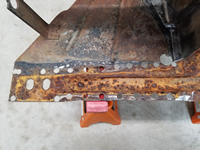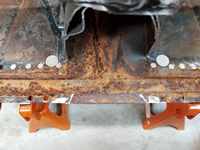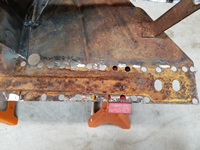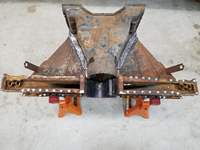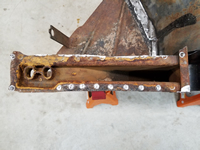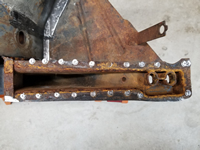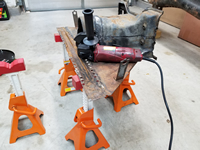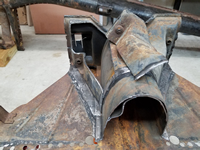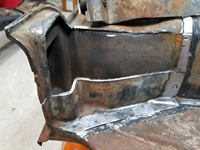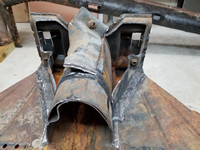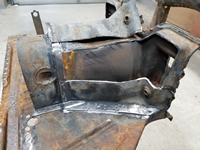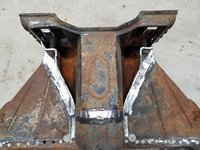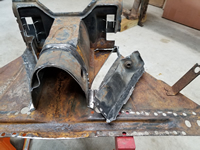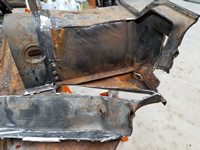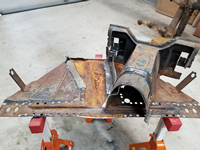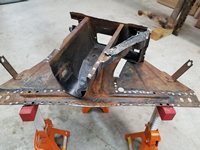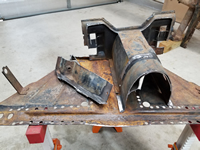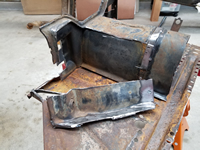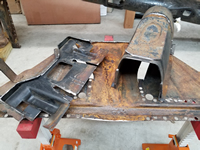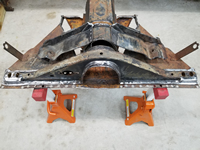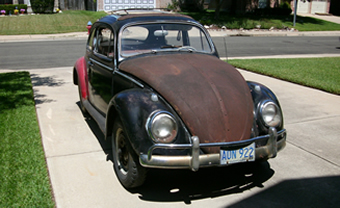Tag: spot weld cutter
Removing Tunnel Bottom Plate
by Garage Weasel on Apr.23, 2018, under Chassis
After considering the pros and cons of removing a section of the tunnel bottom plate, I decided to go ahead and do it. With all of the rust damage that can be seen from outside of the tunnel, I really can't tell if the inside is damaged to the same extent just by looking from the outside. I would expect it to be much less on the top and sides, but the bottom was definitely exposed to water pooling inside of it for many years. Until I take the plate off and look, I will not be able to have an accurate assessment of the damage. Here are some considerations:
Pros: I'll know for sure what damage is there and be able to fully access it to repair it. Areas with rust damage are weaknesses in the structure and must be removed and any rust that is there will just progress and must be stopped. I'll have a better chance of doing that by getting inside and taking a look. Also, large sections of the lip where the floor pans rest on both sides have to be replaced. On the driver's side, it is eaten completely through. Overall, I think it will result in a much better repair when I can get the areas cut out, prepped, and the replacements welded in when having access to the inside. I can also get the inside of that section of the tunnel painted and protected, replace the fuel line, and install seat belt mounting plates.
Cons: The possibility of structural weakness if not properly welded and/or the creation of alignment issues. These are the two biggest downsides to taking the bottom plate off and welding it back on. Of course, any area where the welds are weak are a concern, but so is any unrepaired area with rust damage that is concealed and inaccessible inside of the tunnel. I currently have areas where the rust is a potential weakness and I think as long as I get good weld penetration and good adherence to both parts being welded, structural strength will be achieved. Also, once the bottom plate is removed, the tunnel is very flexible and is easily twisted. This could result in the frame head being in a position where it is not level or tilting. There is going to be a lot welding both for the replacement of the side strips with the floor pan lip and putting the tunnel plate back on and ample chances that those welds will pull the tunnel one way or another. Well on this chassis, so much is going to be replaced and constant checks of alignment and position will have to be made during the rebuilding process anyway. I will just have to check, double-check, and triple-check throughout this process and hope that I can be successful. There are so many areas that are going to have to be replaced on this car with the body as well, so getting this all correct is imperative.
To start taking the bottom plate off, I used a wire wheel in my drill to remove any paint, undercoating, or rust to reveal the spot welds. There are a ton of welds to drill out! My last count was 142.
Important Update: Not knowing what I was doing, I drilled out twice as many spot welds than needed. If you look carefully at the close-up of the spot welds below, there are two types of spot welds - ones that are smooth, dished, and even, and ones where the metal is raised and uneven. The smooth and even ones are the ones that were made using a higher voltage to attach the tunnel bottom plate to the tunnel. These two pieces are thick and the higher voltage melts the metal more, creating a dish in both. The other raised and uneven welds were created when attaching the floor pan to the lip of the tunnel and were created with a lower voltage since the floor pans are thinner. Because of this lower voltage, it doesn't penetrate fully though the tunnel bottom plate and therefore these do not need to be drilled out. An important lesson learned that I will not forget! These were typically alternated, so basically half them were unnecessary.
The area I am going to remove starts with the frame head bottom plate and goes down to where the tunnel starts to flare out to the forks. That area appears to be in great shape, so no need to do anything with it. At the front end of the tunnel bottom plate, it is overlapped by the frame head bottom plate. In its current condition, the overlapped area is just a huge stack of rusted metal that is bulging outward.
The spot weld cutter that I'm using has a pilot to hold the cutter in one place to cut the holes. This works for about three holes and then it starts skating and making deep circular scratches as it skates away. The duller the tip of the pilot gets, the more uncontrollable it becomes. I discovered that if I take a center punch and mark the center of each spot weld and then use a small drill bit around the size of the pilot to drill a shallow hole in each punch mark, the tool is much easier to control and use. It actually saves time in the long run as you are not fighting to keep it on the correct spot and having to stop and restart the cut. Trust me, it's worth the extra effort. It cuts a 3/8-inch hole which is kind of large, but it does a great job of getting the whole spot weld. These are available from Harbor Freight for $5 each.
Next, I made the cross cut at the frame head plate and at the other end of the tunnel plate. Once the cut was made at the frame head end, big chunks of rusted metal just fell off.
And finally, cutting out the spot welds. This took many hours and the good part of one day to accomplish. I started on the driver side at the frame head and would cut out several of them and then gently pry up with a screwdriver to see if the plate was breaking free. I tried very hard not to drill into the lip below it to keep that section intact as much as possible. I would drill down watching the cuttings carefully and looking for rust to appear. Once I saw the rust, I would vacuum the area and look into the hole to see if I was all the way through the plate. This worked well until I got to the middle of the plate. I couldn't see any signs that I missed a spot weld and it just wasn't moving. so I started at the other end thinking that would help, but it was the very same even once it was free on both ends all the way to the middle. I used the screwdriver to attempt to pry it free. No such luck. I decided to take a break and when I was getting up from sitting on my stool, I barely bumped the Napoleon hat with my drill and the whole side popped loose. Of course, the other side was cooperative until I got to the middle and the same thing happened. I started on one end, gave up and started on the other, and got to the middle and it wouldn't break free. In this case, I had a couple of welds that I didn't cut quite deep enough and once I did that, it was completely free. It is amazing how much just part of a couple of spot welds will hold a piece in place! As expected, the top and sides of the inside of the tunnel were in excellent condition looking pretty much the same as they did the day they were initially assembled. The bottom plate itself is in good shape except at the end by the frame head. That end will require a inch or so cut out and a couple of inches added so that it extends to fit underneath the new frame head plate. It's a relief to get the plate off, but I know that I just added many more tasks and many more days of work to an already never-ending list of things to do. Next, I tackle getting the frame head bottom plate off. Should be fun!
Disassembling The Donor Frame Head
by Garage Weasel on May.22, 2018, under Chassis
Well, to start, nothing about disassembling this frame head was easy. Especially if you are trying to preserve the parts to reuse them. It was constructed for structural strength and was not meant to be easy to take apart. Removing the spot welds isn't difficult, but just take a lot of work. The seam welds are another story. Separating the parts that are seam-welded almost always requires sacrificing one of the panels to cut them apart. I started out trying to preserve all the pieces, but finally decided to choose the pieces I wanted the most and do whatever I needed to do to make that as easy as possible. In this case, I really wanted the two lower sections on the sides of the frame head body where the bottom plate is mounted, the Napoleon hat, and as much of the tunnel as I could preserve. I really wanted to save the bottom plate as well, but it was just too difficult to separate it from everything else with all of the seam welds. And although it looked in really good condition from the outside, the bottom plate had deep pits in it where it was covered by the Napoleon hat, the tunnel, and frame head body. I think that the aftermarket bottom plate I purchased will be just as strong as this one considering all of the rust damage. Anyway, I didn't really have a choice in the end and made the sacrifice. Overall, I am really happy with the condition of the parts that were saved. The Napoleon hat is in better shape than the other donor one I purchased and I plan to use some parts of the tunnel section and the lower frame head body sections as well.
First, I carefully removed the undercoating on the bottom plate. Like I said, it appeared to be in really good condition from this side of the plate. I was really hopeful at that point that it would be the same on the other side, even though I could see some pitting through the tunnel opening. I uncovered what I think is a date printed on it of 1.21.76. I'm not sure that is the case here as the frame head was reported to be from a 1965 model.
Next, I used a wire wheel to remove the paint and expose the spot welds. I also marked the ones that I wanted to drill out with a marker. Just like on the tunnel, there are two different types of spot welds on the area where the floor pans were attached. The smooth, even welds are the ones that actually penetrated and bonded the Napoleon hat to the bottom plate and the raised, uneven welds were done at a lower voltage and only bond the floor pans to the upper side of the Napoleon hat. Again, I learned that the hard way.
I then drilled out the spot welds that attach the Napoleon hat to the bottom plate. The hardest areas to separate were where it was seam-welded together. On one side of the Napoleon hat, almost none of the spot welds penetrated because there was too much space between it and the bottom plate. They apparently seam-welded it in that area to compensate. Because of that space, I was able to get a thin cut-off wheel between them and cut through the welds. With the Napoleon hat heavily seam-welded to the tunnel, I just cut through the tunnel so that I could remove it. With the Napoleon hat off, I was both pleased with the condition of the inside of it and not so pleased with the heavy pitting in the matching area of the bottom plate. Apparently, a lot of water was able to get inside the frame head over the years.
By the way, I found that my jack stands worked great for supporting the frame head while I was working on it. The rubber pads grip it and keep it from moving around.
With the Napoleon hat removed, my next task was to remove the lower sides of the frame head body where it is attached to the bottom plate. To do this, I first cut off the areas just above them on both sides and then cut through beam mounting plate on the front to free them there.
It was at this point that I realized just how difficult it was going to be to remove the lower body sections from the bottom plate. The two were seam-welded together and there were was just no easy way to separate them without damaging them both. I really just needed the body sections, so I just cut through the bottom plate in the areas where they were attached. I was a complete bonehead and didn't realize that I was cutting through both layers at one point on the first one. In fact, I didn't notice until I turned it over. I can weld the cut, but really felt sick when seeing it. When cutting the other side, I was very careful not to repeat the same mistake. Once it was cut out, the tunnel was free and I just needed to separate it from the tunnel.
Lastly, I just had to remove the beam mounting plate from the tunnel. They were attached by seam welds, of course, and I just cut out the area of the beam plate where they were attached. Disassembled, finally. The pictures may make it look simple and quick, but I spent several hours on several evenings to get this accomplished. And I still need to clean up the parts I'm going to reuse by removing the leftover panel remnants that were cut out during the removal process and the spot welds.
Mission accomplished and I now have a new donor Napoleon hat, two lower frame head body sections, and a tunnel section to use on my chassis. Can't wait to get to the repair and assembly part of this project!
Follow-up Note (6/9/21): I determined that the parts from this frame head were just too different than my original frame head and purchased a more correct model that matches much better. More details to follow.
